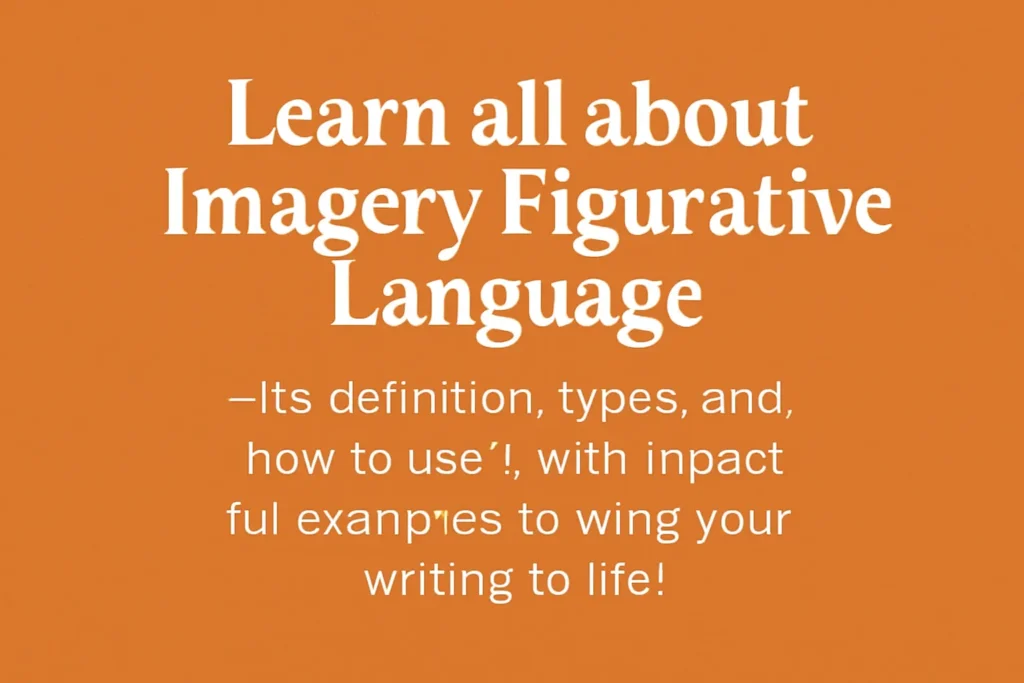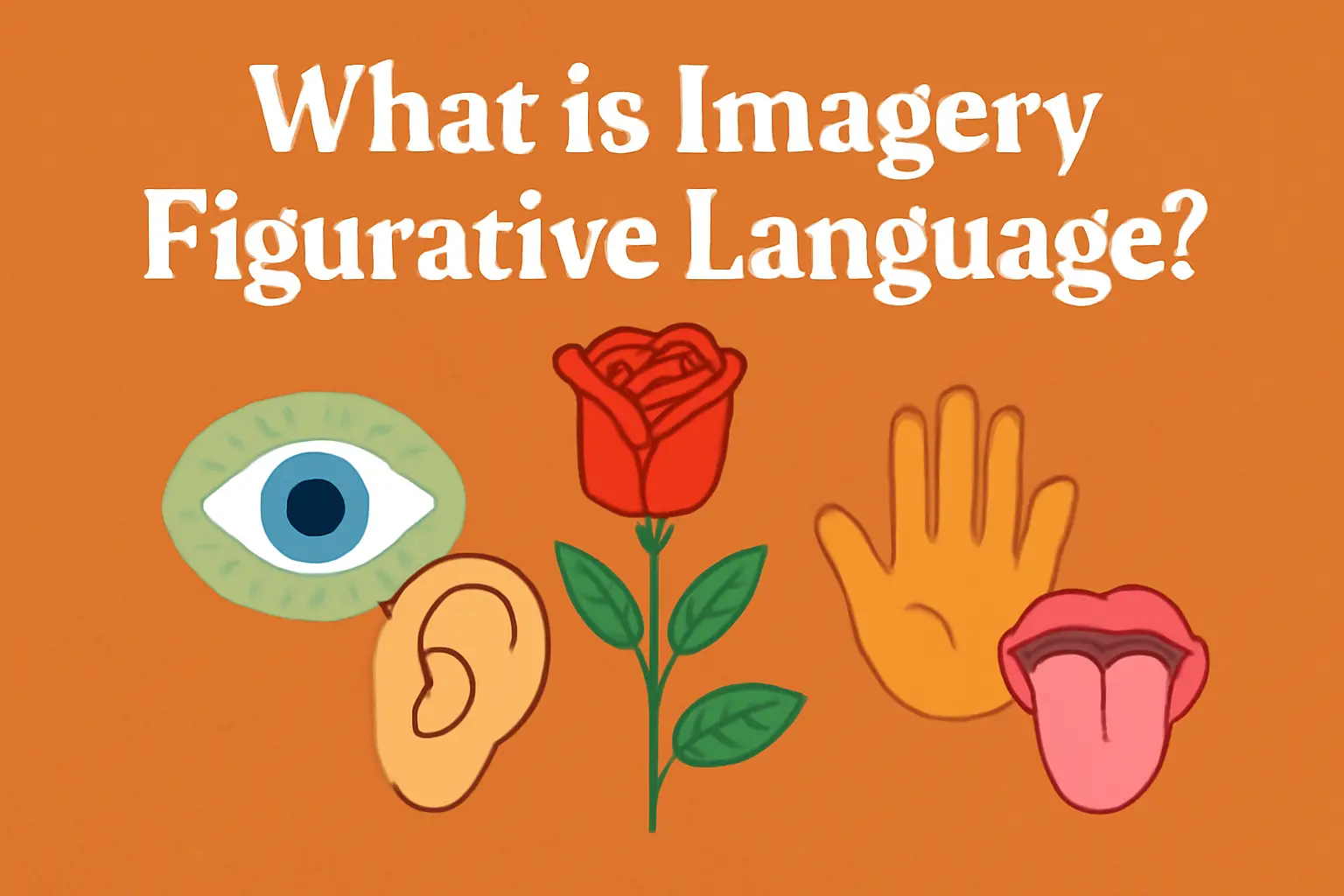Figurative language plays a crucial role in enriching communication and literature, transforming ordinary words into powerful expressions. Among its various forms, imagery stands out as a key tool that appeals to our senses, creating vivid pictures in the mind. But what is imagery figurative language? Simply put, it’s the use of descriptive language that taps into the five senses—sight, sound, touch, taste, and smell—to enhance storytelling and evoke emotions. In this article, we’ll explore the concept of imagery, its importance in figurative language, and how it works to bring writing to life.

What is Figurative Language?
Figurative language refers to the use of words or expressions that go beyond their literal meaning to create a more vivid or impactful description. It helps writers communicate complex ideas, emotions, and images in a way that is more engaging and relatable to the reader. What is imagery figurative language? Imagery is one example, where descriptive language appeals to the senses, creating mental pictures. By using figurative language, writers can add layers of meaning, making their writing more dynamic and compelling.
Also Check our: Figurative Language Checker too
Figurative language plays a significant role in enriching content, allowing the writer to express feelings, settings, and actions in ways that resonate more deeply with the reader. Common types of figurative language include metaphors, similes, and personification. A metaphor compares two unrelated things without using “like” or “as” (e.g., “Time is a thief”). A simile uses “like” or “as” to compare (e.g., “Her smile is like sunshine”). Personification gives human qualities to non-human things (e.g., “The wind whispered through the trees”). These techniques make writing more expressive and memorable.
What is Imagery?
Imagery is a literary device used by writers to create vivid pictures in the reader’s mind by appealing to the five senses: sight, sound, taste, touch, and smell. What is imagery figurative language? It is the use of descriptive language to evoke these senses, allowing the reader to experience the story or scene in a more immersive way. By incorporating imagery, writers bring their writing to life, making it more engaging and emotionally impactful.
The purpose of imagery is to help readers connect with the text on a deeper level by stimulating their senses. Whether it’s the soft, warm glow of the morning sun (sight), the crisp sound of leaves crunching underfoot (sound), or the sweet taste of fresh fruit (taste), imagery helps create a more vivid, memorable experience. This sensory-rich writing draws readers in, making them feel as if they are part of the world the writer is creating. Through imagery, writers can transform ordinary descriptions into powerful, emotional moments that resonate with their audience.
Types of Imagery
Imagery comes in various forms, each designed to appeal to one of the five senses. What is imagery figurative language? It’s a tool used to create vivid sensory experiences through words. Here are the main types of imagery:
- Visual Imagery: This type appeals to the sense of sight. It helps readers picture scenes and objects in their mind. Example: “The golden sun dipped behind the mountains,” paints a vivid picture of a sunset.
- Auditory Imagery: It triggers the sense of sound, adding depth to the scene. Example: “The leaves rustled in the gentle breeze,” makes the reader almost hear the soft sound of nature.
- Olfactory Imagery: This imagery connects to the sense of smell. Example: “The aroma of fresh-baked bread filled the room,” evokes the scent of a warm kitchen.
- Gustatory Imagery: This appeals to the sense of taste. Example: “The sweet, tangy lemonade refreshed her on the hot summer day,” brings the taste of a cold drink to life.
- Tactile Imagery: It engages the sense of touch. Example: “The rough surface of the stone scraped her fingers,” helps readers feel the texture.
These different types of imagery help create a richer, more immersive experience for readers.
How Does Imagery Enhance Writing?
What is imagery figurative language and how does it enhance writing? Imagery helps create a stronger emotional connection with readers by painting vivid mental pictures. By appealing to the senses, imagery draws readers into the world the writer is creating, making them feel more emotionally engaged with the story or message.
Imagery also plays a crucial role in setting the mood and tone of a piece. For example, describing a stormy sky with “dark clouds swirling in the angry wind” instantly sets a tense, ominous tone, while “the soft glow of the golden sunrise” can create a calm and peaceful mood. The choice of words and sensory details shapes how readers perceive the scene and feel about it.
Furthermore, imagery makes descriptions more vivid, memorable, and engaging. When a writer describes the “sweet scent of blooming roses” or the “sharp, icy wind,” it creates a lasting image in the reader’s mind. This sensory-rich writing leaves a deeper impression, making the content more enjoyable and easier to connect with.
Examples of Imagery in Literature
What is imagery figurative language in classic literature? Imagery is used by authors to create vivid pictures that enhance the reader’s experience. In Shakespeare’s Macbeth, he uses visual imagery to set a dark, foreboding tone: “Out, out brief candle! Life’s but a walking shadow.” This powerful image deepens the theme of life’s fleeting nature.
Similarly, Emily Dickinson’s poem “A Bird Came Down the Walk” uses tactile and visual imagery: “And then he drank a Dew / From a convenient Grass.” This brings the scene to life, making it more relatable and immersive.
By using imagery, both authors enrich their storytelling, allowing readers to connect emotionally and visually with the narrative.
Imagery in Everyday Language
What is imagery figurative language outside of literature? Imagery is not just confined to books and poems; it’s widely used in everyday language, from advertising to movies and music lyrics. For example, in advertising, a commercial for a car might say, “Feel the wind rush through your hair as you drive,” using sensory imagery to create a sense of freedom and excitement.
In movies, visuals like “the dark alley illuminated only by a flickering streetlight” set the mood for suspense. Similarly, music lyrics like “the scent of rain on dry earth” evoke emotions and help listeners connect deeply with the song.
By using imagery, communication becomes more relatable, engaging, and memorable. It makes abstract concepts tangible, allowing audiences to visualize and feel the message being conveyed.
Also Check: Color to Black & White Converter
Common Mistakes When Using Imagery
What is imagery figurative language and how can it be misused? While imagery can enrich writing, overuse or misuse can detract from its effectiveness. When too many sensory details are added, it can overwhelm the reader, making the writing feel cluttered and confusing. For example, describing every object in a scene with excessive detail can distract from the main message.
Another common mistake is a lack of clarity. Imagery should always contribute meaningfully to the message, not just be there for decoration. If the imagery is too vague or disconnected from the context, it can confuse readers instead of enhancing their experience. To avoid these mistakes, writers should focus on clear, purposeful imagery that supports the narrative.
How to Create Effective Imagery
What is imagery figurative language and how can writers create it effectively? To craft strong, evocative imagery, it’s important to use vivid descriptions that appeal to multiple senses. Instead of just describing what something looks like, engage the senses of touch, smell, sound, and taste to create a fuller, richer picture for the reader.
Using metaphors and similes can also enhance the effectiveness of imagery. By comparing one thing to another, writers can help readers visualize the scene more clearly. For example, saying “Her eyes sparkled like diamonds” creates a stronger, more memorable image than just saying “Her eyes were bright.”
By focusing on clear, sensory-rich descriptions and using figures of speech like metaphors and similes, writers can make their imagery more impactful and engaging.
Also Read: How to Write a Descriptive Essay
Conclusion
What is imagery figurative language and why is it important? Imagery is a powerful tool in figurative language that helps writers create vivid, sensory-rich experiences for their readers. By appealing to the senses, imagery enhances storytelling and makes it more engaging. Whether it’s visual, auditory, or tactile, imagery brings scenes to life and connects readers to the narrative on a deeper level.
Writers are encouraged to experiment with imagery in their own work to make their writing more compelling and immersive. Additionally, exploring other forms of figurative language, such as metaphors and similes, can further enrich writing and make it more dynamic.

